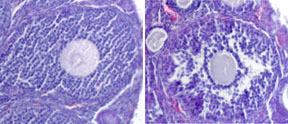 |
Office of Media Relations | |||
News | ||||
|
A Surprising Pair of Proteins Help Make Healthy Eggs
Biologists at Brown University and the University of California–Berkeley have discovered that two proteins team up to turn on an assortment of ovarian genes critical to the production of healthy eggs. This finding, published in the Proceedings of the National Academy of Sciences, sheds important light on the biochemical processes underpinning fertility. PROVIDENCE, R.I. – Human eggs rely on handmaidens. Called granulosa cells, they surround eggs and deliver nutrients and hormones. Without granulosa cells, eggs cannot mature and be successfully fertilized. How do these handmaidens grow? Biologists at Brown University and the University of California–Berkeley have discovered that two proteins – TAF4b and c-Jun – team up to turn on about two dozen genes inside the nuclei of granulosa cells. This subset of genes, in turn, writes the genetic code for proteins that cause granulosa cells to multiply and nurture developing eggs. The finding, published in an advanced online edition of the Proceedings of the National Academy of Sciences, provides an important piece of the reproduction puzzle, and it points to possible drug targets for treating infertility and ovarian cancer.  The biochemistry of fertility “Thousands of women in this country undergo fertility treatments each year and some have no idea why they can’t get pregnant,” said Richard Freiman, an assistant professor in the Department of Molecular Biology, Cell Biology and Biochemistry at Brown. “This research gives us important new information about fertility. It’s a basic science finding, but it may provide answers for some of these women and, possibly, lead to better in-vitro fertilization therapies.” In 2001, Freiman and colleagues at Berkeley published a paper in Science describing the essential role a transcription factor called TAF4b plays in the fertility of female mice. Without this protein, egg-producing ovarian follicles didn’t develop properly. The result: infertile mice. The new research underscores TAF4b’s central role in normal reproduction. The Brown and Berkeley team found that in the granulosa cells of the ovary, it triggers production of another protein, called c-Jun, and together they switch on a network of ovarian genes that help promote granulosa cell proliferation. “The big surprise was c-Jun,” Freiman said. That’s because this well-studied protein is found at high levels in damaged nerve tissue as well as in the tumors of certain cancers, including cancer of the skin and liver and in Hodgkin’s lymphoma. The new research is the first to connect c-Jun to this network of ovarian genes. Freiman said the discovery reveals a potential connection between TAF4b and c-Jun and the formation of a rare kind of ovarian cancer that springs from granulosa cells. The scientists arrived at their findings by creating two matched rat cell lines of ovarian granulosa cell origin. In the experimental line, the level of TAF4b was increased. Berkeley researchers compared these lines and were able to identify the cooperative role of TAF4b and c-Jun, as well as the activation of the network of genes they control. In parallel, Brown scientists studied the defective ovaries of TAF4b-deficient mice. What they found in mice was similar to what the Berkeley team found in cultured cells: When the level of TAF4b protein decreased, granulosa cells withered, broke apart and failed to multiply. A similar process may be at work in some infertile women. Freiman plans to extend these studies to human granulosa tumors as well as explore a possible link between TAF4b and other forms of ovarian cancer, the fourth leading cause of cancer deaths among women. Ekaterina Voronina, a Brown postdoctoral research fellow, assisted with the research. The Berkeley team included lead author Kenneth Geles, Wei-Li Liu and Shuang Zheng. Berkeley Professor Robert Tijan, an investigator with the Howard Hughes Medical Institute, oversaw the work. The National Institutes of Health, the American Cancer Society, and the Howard Hughes Medical Institute funded the work. ###### Media Relations Home | Top of File | e-Subscribe | Brown Home Page | ||||